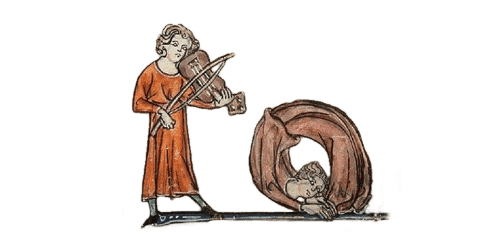Viva fui in silvis; dum vixi tacui: mortua dulce cano.
~I was alive in the woods; while I lived I was silent; now dead, I sing sweetly.
Spruce, maple, boxwood, rosewood, snakewood, sheeps gut, horses tail, crows quill, elephant's tusk, rams horn, and, according to legend, the shell of a tortoise—like the ingredients of a sorcerers potion, these once-living remnants of plants, birds, and animals are transformed into musical instruments and need only our breath or touch to bring them to life.
Although musical instruments have existed for millennia, the writing-down of their music was not common until circa 1500. (Vocal part-music had enjoyed a written tradition for several centuries by then.)
During a brief period around 1600, musicians in an ensemble of six instruments (referred to on the Continent as an “English Consort ) made arrangements of popular tunes and part-music for themselves to play. The English consort flourished in the City of London, in Oxford, and in other venues where serious amateur and professional music-making took place. Their instruments were the same as those of the Baltimore Consort: the ‘sultry’ treble viol (or violin), the “ethereal” flute (or recorder), the ‘noble’ lute, the “sprightly and cheerful” cittern, the deep bandora, and the ‘stately bass viol—a combination which became known in the 20th century as a broken consort because it mixed instruments from different families. The term itself—broken consort—although invented later, nevertheless has an historic resonance: Shakespeare spoke of “broken music," by which he meant “breaking the around or devising a melody which is ‘broken (made ornamental) through division into many small notes.
Enter, The Baltimore Consort
The Baltimore Consort was founded to perform instrumental music of Shakespeare's time. Although later joined by a singer, the group's experience of rehearsing purely instrumentally forged its identity as an ensemble dedicated to exploiting the diverse sound colors offered by gut- and wire-strung, plucked and bowed strings, and transverse and end-blown flutes and recorders, capped reeds and percussion.
Shakespeare's music tapped into the popular repertory of the Elizabethan period—the tunes heard in taverns, on street corners, in the theater, and accompanying dancing. Thomas Morley's The First Book of Consort Lessons (1599), together with the manuscript part-books of Matthew Holmes, are the ‘mother’ sources for consort arranging in that time, and thus provide the music which the Baltimore Consort initially performed.
Realizing that these sources demonstrated arranging techniques which could then be applied to other early tunes, the Consort began its journey through the popular music of England, Scotland, France, Germany, Italy, and Spain, as well as into the traditional music of today that is rooted in earlier times.
Having expanded upon the musical arrangements of Shakespeare's contemporaries, the Consort nevertheless enjoys returning to its origins—the English music for broken consort. The music of that time is an inspiration and joy, just as it was for listeners in 1600, as witnessed by a poem on the power of music by Richard Edwards (partially quoted in Shakespeare's Romeo and Juliet act iv, scene 5):
Where gripinge grefes the hart woula wounde,
ana dolefulle dumps the mynde oppresse,
There Musick with her silver sound
is wont with spede to give redresse.
Of troublea minde for every sore,
swete Musick hath a salve therfore.


